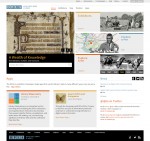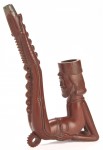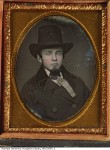 At noon today, the Digital Public Library of America opened for business. Modeled on the greatness that is the Europeana library, the DPLA collects more than two million objects from museums, historical archives, universities and libraries across the country. The focus is American cultural history as reflected in photographs, manuscripts, letters, maps, artifacts, books, audio, films and more, all drawn from contributing institutions like the Smithsonian, the National Archives, the New York Public Library, Harvard University, the David Rumsey Historical Map Collection and the University of Virginia. The DPLA conveniently collates material already online — things you could find if you searched the websites of those institutions individually — but it also includes items that have been digitized but were isolated on local computer systems.
At noon today, the Digital Public Library of America opened for business. Modeled on the greatness that is the Europeana library, the DPLA collects more than two million objects from museums, historical archives, universities and libraries across the country. The focus is American cultural history as reflected in photographs, manuscripts, letters, maps, artifacts, books, audio, films and more, all drawn from contributing institutions like the Smithsonian, the National Archives, the New York Public Library, Harvard University, the David Rumsey Historical Map Collection and the University of Virginia. The DPLA conveniently collates material already online — things you could find if you searched the websites of those institutions individually — but it also includes items that have been digitized but were isolated on local computer systems.
The library’s goal is to be a history-targeted Google, a vast repository of historical information that is open to the public and fully searchable. It has none the barriers that keep certain institutional sites from being included in Google search results, and unlike Wikipedia, its contents are mainly primary sources. The hope is that it will prove itself to be an invaluable tool for research, where students, teachers, scholars, journalists and happy nerds in general can get information from the horse’s mouth instead of via layers of edited composition. You can search by keyword, or browse by subject, and if you register for an account, you can save your searches, individual items and exhibitions and make shareable playlists out of them.
The contents are not exclusively American since many of the contributing institutions have artifacts from other countries that have been uploaded to the digital library, plus there are collaborations with international counterparts planned. DPLA has already partnered with Europeana on an app which allows users to search both databases at once, and they are working together to create an exhibition about European emigration to the United States during the boom years of the 19th and 20th centuries. The exhibition will bring together manuscripts, photographs, historical records from the Bibliotheque Nationale de France, the National Gallery of Ireland, the Jewish Museum of London, the Royal Library of the Netherlands, the Saxon State Library and the Norwegian Photo Archives.
 That one is not available yet, but the library has compiled seven online exhibitions to kick off festivities. What’s cool about them is they each have a local flavor since the topics are drawn from specific partner collections and then fleshed out with additional substance from other institutions. For example, the History of Survivance: Upper Midwest 19th Century Native American Narratives exhibit is about Native American communities in Minnesota. It taps the Minnesota Digital Library and Minnesota Historical Society for period photographs and artifacts which exemplify the times and cultures being explored.
That one is not available yet, but the library has compiled seven online exhibitions to kick off festivities. What’s cool about them is they each have a local flavor since the topics are drawn from specific partner collections and then fleshed out with additional substance from other institutions. For example, the History of Survivance: Upper Midwest 19th Century Native American Narratives exhibit is about Native American communities in Minnesota. It taps the Minnesota Digital Library and Minnesota Historical Society for period photographs and artifacts which exemplify the times and cultures being explored.
It’s the kind of thing you would get to enjoy if you lived in Minnesota and could check out the new show at the historical society. Most people don’t have that opportunity, however, and I love that even with its vastly wide rubric, the DPLA is dedicated to showcasing local history. The Minnesota sites are excellent in their own right, but I don’t know how many times I’ve been researching a story or link-surfing only to reach a local history site that has very limited resources and few options for sharing the wealth of their collections, archives, curatorial knowledge. The DPLA can give those sorts of institutions a great boost to their Internet presence as well as send them new real-life eyeballs.
The best part, other than having everything in one place, is how easy it is to stumble on collections you didn’t know existed. Did you know that Harvard University Library has a collection of 3,500 daguerreotypes, 3,106 of which have been digitized and are available to view over the Internet? I can never get enough of daguerreotypes so that’s good and bookmarked now. I found that by popping around the timeline, and I found the Digital Library of Georgia by letting my clicking finger do the walking over the map.
 There are still some vagaries and bugs here and there. If you travel the timeline, for example, and drag the selecting tool to the decade you want, there are bars of varying length reflecting the number of artifacts in the database from the years you picked. However, sometimes when you click on a year that in decade view claimed to have an item, in year view it’s showing zero items. Also, when you’re going through the exhibits and you click on the information icon, the info includes the URL to the artifact on its home website, but it’s not hot so you have to copy and paste it into the browser address bar to go there. Another nit to pick is that the images, while almost all of them are highly zoomable, can’t be opened full-size.
There are still some vagaries and bugs here and there. If you travel the timeline, for example, and drag the selecting tool to the decade you want, there are bars of varying length reflecting the number of artifacts in the database from the years you picked. However, sometimes when you click on a year that in decade view claimed to have an item, in year view it’s showing zero items. Also, when you’re going through the exhibits and you click on the information icon, the info includes the URL to the artifact on its home website, but it’s not hot so you have to copy and paste it into the browser address bar to go there. Another nit to pick is that the images, while almost all of them are highly zoomable, can’t be opened full-size.
That’s small potatoes, though. Let’s not forget that when Europeana debuted, it was so hugely popular that the whole site crashed and was completely out of commission for months. Minor weirdnesses are to be expected in the early days, and the DPLA is going to be expanding mightily over the next years. Future plans include apps, the library used a developer platform by third parties, partnerships with additional institutions and, avoiding the controversies that bogged down Google Books, some kind of digital lending model for works — books and other media — that are still under copyright.
So off you go, then. Cancel all your plans for the weekend and have yourself a voyage through time, space and culture instead.
This is very wonderful! Thanks for sharing and for the details!
This information sounds and looks fantastic thank you.
Years and years from now history buffs will look back on the opening of this blog and say YES!